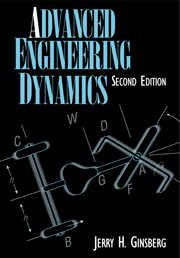Book contents
- Frontmatter
- Contents
- Preface
- Chapter 1 Basic Considerations
- Chapter 2 Particle Kinematics
- Chapter 3 Relative Motion
- Chapter 4 Kinematics of Rigid Bodies
- Chapter 5 Newtonian Kinetics of a Rigid Body
- Chapter 6 Introduction to Analytical Mechanics
- Chapter 7 Further Concepts in Analytical Mechanics
- Chapter 8 Gyroscopic Effects
- Appendix Centroidal Inertia Properties
- Answers to Even-Numbered Problems
- Index
Chapter 5 - Newtonian Kinetics of a Rigid Body
Published online by Cambridge University Press: 05 June 2012
- Frontmatter
- Contents
- Preface
- Chapter 1 Basic Considerations
- Chapter 2 Particle Kinematics
- Chapter 3 Relative Motion
- Chapter 4 Kinematics of Rigid Bodies
- Chapter 5 Newtonian Kinetics of a Rigid Body
- Chapter 6 Introduction to Analytical Mechanics
- Chapter 7 Further Concepts in Analytical Mechanics
- Chapter 8 Gyroscopic Effects
- Appendix Centroidal Inertia Properties
- Answers to Even-Numbered Problems
- Index
Summary
Chasle's theorem states that the general motion of a rigid body can be represented as a superposition of a translation following any point in the body and a pure rotation about that point. Kinematics studies are concerned only with the description of that motion. The developments in this chapter will disclose how the motion is related to the force system acting on the body. The resultant force may be regarded intuitively as the net tendency of the force system to push a body, so it may be expected to be related to the translational effect. Similarly, the resultant moment may be considered to be the net rotational effect. We shall confirm and quantify these expectations in the following presentation for general spatial motion, and then specialize the derived principles for the case of planar motion.
Fundamental Principle
Newton's laws govern the motion of a particle. A rigid body may be treated as a collection of particles whose motions are not independent. In the first part of this chapter, we shall derive the basic kinetics principles for rigid-body motion. The foundation for these derivations is Newton's second law, which describes inertial effects, and the third law, which describes the nature of the force system.
Basic Model
From a philosophical perspective, we initially recognize the atomic nature of matter by considering a body to consist of N particles having mass mi .
Information
- Type
- Chapter
- Information
- Advanced Engineering Dynamics , pp. 163 - 244Publisher: Cambridge University PressPrint publication year: 1995
